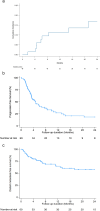Efficacy and safety of image-guided hypofractionated radiotherapy for hepatocellular carcinoma with portal vein tumor thrombosis: a retrospective, multicenter study
- PMID: 40254568
- PMCID: PMC12010600
- DOI: 10.1186/s12885-025-13739-3
Efficacy and safety of image-guided hypofractionated radiotherapy for hepatocellular carcinoma with portal vein tumor thrombosis: a retrospective, multicenter study
Abstract
Background: External beam radiation therapy (RT) has shown promising effects for hepatocellular carcinoma (HCC) patients with portal vein tumor thrombosis (PVTT) in recent studies. However, there is still a lack of consensus on the optimal RT scheme for PVTT treatment. We evaluated the efficacy and safety of image-guided 10-fraction hypofractionated RT in these patients.
Methods: Between January 2016 and March 2022, a total of 95 HCC patients with PVTT received 10-fraction hypofractionated image-guided radiation therapy (IGRT) at two institutes, and 69 patients were analyzed. Follow-up imaging was performed at three-month intervals after the completion of RT. The extent of PVTT was described according to the Liver Cancer Study Group of Japan classification: Vp1 = segmental portal vein branch, Vp2 = right/left anterior/posterior portal vein, Vp3 = right/left portal vein, and Vp4 = main portal vein. Response evaluation was performed using Response Evaluation Criteria in Solid Tumors, version 1.1. Freedom from local progression (FFLP), progression-free survival (PFS), and overall survival (OS) were calculated from the start date of RT.
Results: The median prescribed dose of 50 Gy (range: 40-50 Gy; biologically effective dose [BED]: 56-75Gy10) was delivered in 10 fractions. In this cohort, 4.3% of patients had Vp1, 20.3% had Vp2, 37.7% had Vp3, and 37.7% had Vp4. Median Planning target volume was 105.3 cc (interquartile range [IQR], 74.1-179.4 cc). Fifty-two (75.4%) patients received 50 Gy. With a median follow-up of 10.2 months (IQR, 6-21 months), the median OS was 20.3 months, and 1-year FFLP, PFS, and OS rates were 88.7%, 26.9%, and 62.2%, respectively. At 3 months follow-up, 13.0% had a complete response, 36.2% had a partial response, 46.4% had a stable disease and 4.4% had a progressive disease. In the multivariate analysis, alpha-fetoprotein level ≥ 600 IU/ml (hazard ratio [HR] 2.06, p = 0.03), Child-Pugh Class B or C (HR 2.30, p = 0.02), and stage IVA or IVB (4.05, p = 0.02) were significantly related to OS. During the follow-up period, there were 2 (2.9%) cases of grade ≥ 3 toxicity: grade 3 liver enzyme elevation (n = 1), and acute cholangitis (n = 1).
Conclusions: Hypofractionated RT demonstrated promising local PVTT control and OS rates with acceptable toxicity. These data suggest that 10-fraction image-guided hypofractionated RT (BED: 56-75 Gy10) is a feasible treatment option for PVTT in HCC patients.
Keywords: Hepatocellular carcinoma; Hypofractionated radiation therapy; Image-guided radiation therapy; Portal vein tumor thrombosis.
© 2025. The Author(s).
Conflict of interest statement
Declarations. Ethics approval and consent to participate: The study was conducted in accordance with the Declaration of Helsinki, and approved by the Institutional Review Board of Seoul National University Hospital and Chung-Ang University Hospital. Informed consent requirement was waived by institutional review board of Seoul National University Hospital and Chung-Ang University Hospital due to the retrospective nature of the study. (IRB No. H-2205–143-1327). Consent for publication: Not applicable. Competing interests: The authors declare no competing interests.
Figures




Similar articles
-
CT-guided high-dose-rate brachytherapy ablation of HCC patients with portal vein tumor thrombosis.Eur Radiol Exp. 2025 Feb 14;9(1):16. doi: 10.1186/s41747-025-00564-3. Eur Radiol Exp. 2025. PMID: 39951200 Free PMC article.
-
Advanced radiotherapy technique in hepatocellular carcinoma with portal vein thrombosis: Feasibility and clinical outcomes.PLoS One. 2021 Sep 23;16(9):e0257556. doi: 10.1371/journal.pone.0257556. eCollection 2021. PLoS One. 2021. PMID: 34555075 Free PMC article.
-
Extent of portal vein tumour thrombosis in patients with hepatocellular carcinoma: The more, the worse?Liver Int. 2019 Feb;39(2):324-331. doi: 10.1111/liv.13988. Epub 2018 Nov 9. Liver Int. 2019. PMID: 30318826
-
Is hepatocellular carcinoma complicated with portal vein tumor thrombosis potentially curable by radiotherapy in the form of stereotactic body radiation therapy?Int J Radiat Biol. 2022;98(10):1495-1509. doi: 10.1080/09553002.2022.2055800. Epub 2022 Apr 4. Int J Radiat Biol. 2022. PMID: 35311612 Review.
-
Management of hepatocellular carcinoma patients with portal vein tumor thrombosis: A narrative review.Hepatobiliary Pancreat Dis Int. 2022 Apr;21(2):134-144. doi: 10.1016/j.hbpd.2021.12.004. Epub 2021 Dec 16. Hepatobiliary Pancreat Dis Int. 2022. PMID: 34955380 Review.
Cited by
-
Locoregional Therapies for Hepatocellular Carcinoma with Portal Vein Tumor Thrombus.J Gastrointest Cancer. 2025 Jul 23;56(1):162. doi: 10.1007/s12029-025-01280-2. J Gastrointest Cancer. 2025. PMID: 40699271 Free PMC article. Review.
References
-
- Global Burden of Disease Cancer Collaboration, Fitzmaurice C, Allen C, Barber RM, Barregard L, Bhutta ZA, et al. Global, Regional, and National Cancer Incidence, Mortality, Years of Life Lost, Years Lived With Disability, and Disability-Adjusted Life-years for 32 Cancer Groups, 1990 to 2015: A Systematic Analysis for the Global Burden of Disease Study. JAMA Oncol. 2017;3:524–48. - PMC - PubMed
-
- World Health Organization International Agency for Research on Cancer (IARC). Global Cancer Observatory: Cancer Today. Lyon, France: World Health Organization. https://gco.iarc.fr/. Accessed 14 Mar 2023.
-
- Sung H, Ferlay J, Siegel RL, Laversanne M, Soerjomataram I, Jemal A, et al. Global Cancer Statistics 2020: GLOBOCAN Estimates of Incidence and Mortality Worldwide for 36 Cancers in 185 Countries. CA Cancer J Clin. 2021;71:209–49. - PubMed
Publication types
MeSH terms
Grants and funding
LinkOut - more resources
Full Text Sources
Medical

